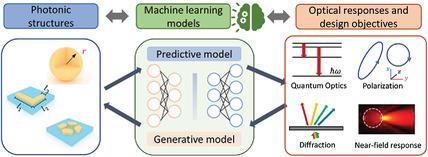Our official English website, www.x-mol.net, welcomes your
feedback! (Note: you will need to create a separate account there.)
Tackling Photonic Inverse Design with Machine Learning
Advanced Science ( IF 14.3 ) Pub Date : 2021-01-07 , DOI: 10.1002/advs.202002923 Zhaocheng Liu 1 , Dayu Zhu 1 , Lakshmi Raju 1 , Wenshan Cai 1, 2
Advanced Science ( IF 14.3 ) Pub Date : 2021-01-07 , DOI: 10.1002/advs.202002923 Zhaocheng Liu 1 , Dayu Zhu 1 , Lakshmi Raju 1 , Wenshan Cai 1, 2
Affiliation

|
Machine learning, as a study of algorithms that automate prediction and decision‐making based on complex data, has become one of the most effective tools in the study of artificial intelligence. In recent years, scientific communities have been gradually merging data‐driven approaches with research, enabling dramatic progress in revealing underlying mechanisms, predicting essential properties, and discovering unconventional phenomena. It is becoming an indispensable tool in the fields of, for instance, quantum physics, organic chemistry, and medical imaging. Very recently, machine learning has been adopted in the research of photonics and optics as an alternative approach to address the inverse design problem. In this report, the fast advances of machine‐learning‐enabled photonic design strategies in the past few years are summarized. In particular, deep learning methods, a subset of machine learning algorithms, dealing with intractable high degrees‐of‐freedom structure design are focused upon.
中文翻译:

利用机器学习解决光子逆向设计问题
机器学习作为一门基于复杂数据自动预测和决策的算法研究,已成为人工智能研究中最有效的工具之一。近年来,科学界逐渐将数据驱动的方法与研究相结合,在揭示潜在机制、预测基本特性和发现非常规现象方面取得了巨大进展。它正在成为量子物理、有机化学和医学成像等领域不可或缺的工具。最近,机器学习已被应用于光子学和光学研究中,作为解决逆向设计问题的替代方法。在本报告中,总结了过去几年机器学习光子设计策略的快速进展。特别是深度学习方法(机器学习算法的一个子集),处理棘手的高自由度结构设计。
更新日期:2021-03-03
中文翻译:

利用机器学习解决光子逆向设计问题
机器学习作为一门基于复杂数据自动预测和决策的算法研究,已成为人工智能研究中最有效的工具之一。近年来,科学界逐渐将数据驱动的方法与研究相结合,在揭示潜在机制、预测基本特性和发现非常规现象方面取得了巨大进展。它正在成为量子物理、有机化学和医学成像等领域不可或缺的工具。最近,机器学习已被应用于光子学和光学研究中,作为解决逆向设计问题的替代方法。在本报告中,总结了过去几年机器学习光子设计策略的快速进展。特别是深度学习方法(机器学习算法的一个子集),处理棘手的高自由度结构设计。











































 京公网安备 11010802027423号
京公网安备 11010802027423号